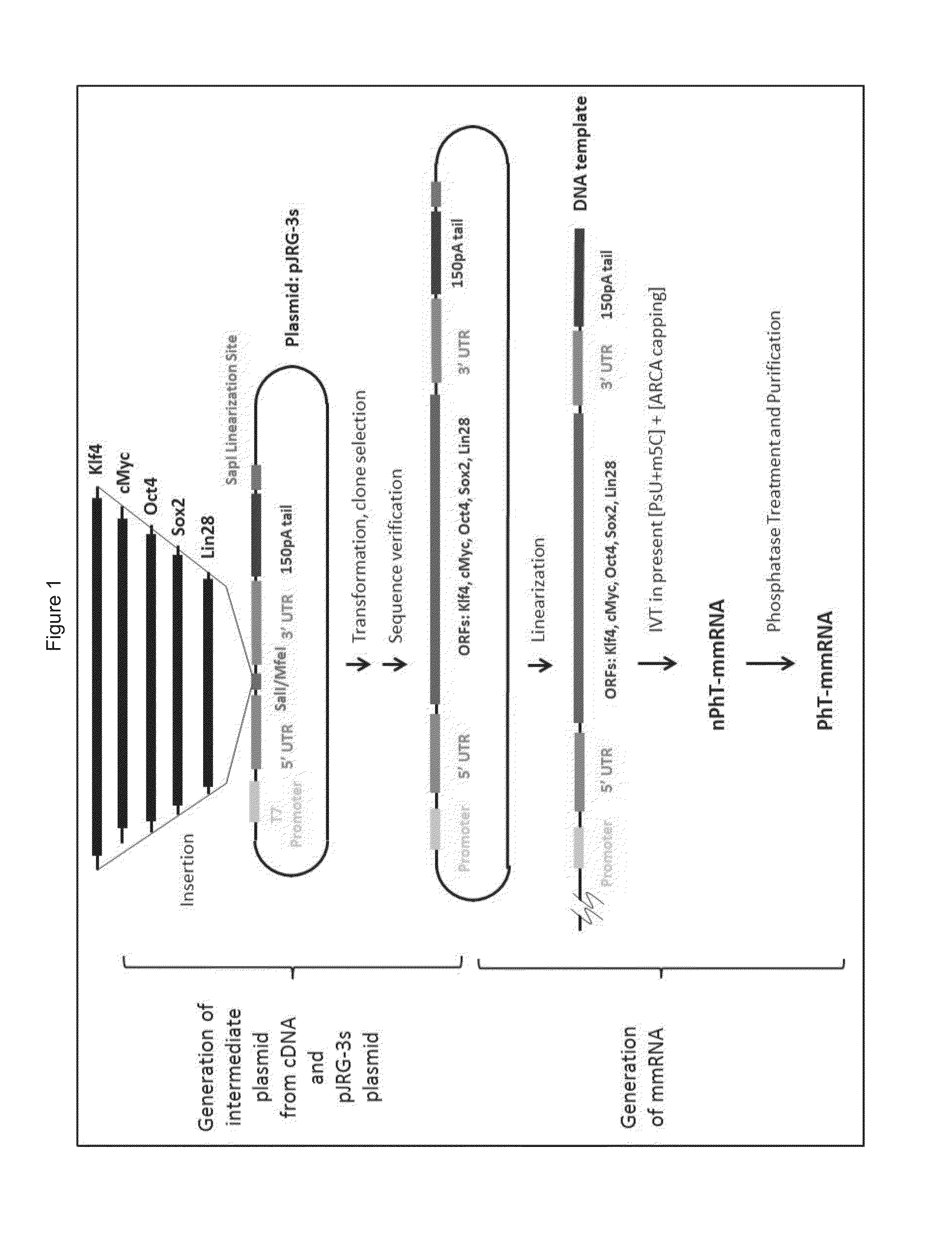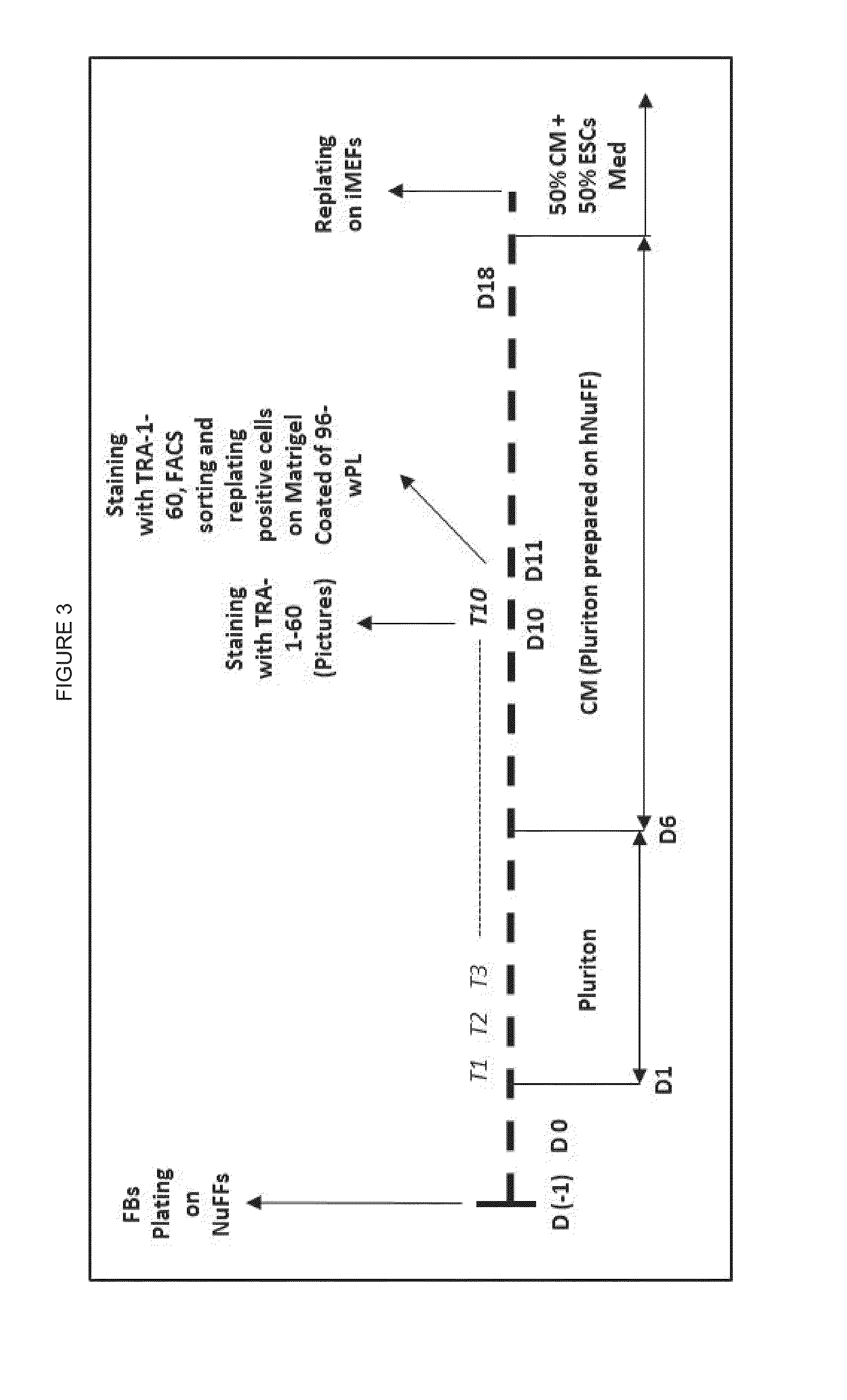ACTIVATION OF INNATE IMMUNITY FOR ENHANCED NUCLEAR REPROGRAMMING OF SOMATIC CELLS WITH mRNA
a technology of innate immunity and nuclear reprogramming, which is applied in the field of activation of innate immunity for enhanced nuclear reprogramming of somatic cells with mrna, can solve the problems of low reprogramming efficiency, inability to provide precise control of the reprogramming process, and many unknowns about the underlying causes, so as to achieve the effect of enhancing transdifferentiation
- Summary
- Abstract
- Description
- Claims
- Application Information
AI Technical Summary
Benefits of technology
Problems solved by technology
Method used
Image
Examples
example 1
Activation of Innate Immunity Enhances the Effect of RNA Treatment
[0096]We have found that activation of innate immunity is essential for efficient nuclear reprogramming. During reprogramming of cells with modified mRNA, it was found that retaining the 5′ triphosphate in at least a portion of artificially synthesized RNA constructs is important for efficient mmRNA-based reprogramming of fibroblasts to induced pluripotent stem cells.
[0097]Mammalian cells contain RNA sensors that activate the innate immune system. Activation of innate immunity can cause inflammation or apoptosis. Accordingly, in an attempt to substantially reduce the activation of innate immunity, investigators have modified therapeutic RNA by incorporating modified nucleosides, and by removing the 5′ triphosphate of the synthesized RNA. Innate immune activation, through the human TLR3, TLR7, and TLR8 receptors; or through the PKR (protein kinase R) pathway is thereby reduced. See, for example, Kariko et al. (2005) Im...
example 2
Importance of Innate Immune Signaling in Telomere Extension
[0108]Human Endothelial cells are cultivated on complete medium and at Passage 14 pretreated with different NF-κB and PKR inhibitors. Subsequently, cells are transfected with hTERT or p-hTERT mmRNAs using Lipofectomin RNiMax for a total of three transfections at 48-hour intervals. Two days after the third treatment all treated cells and controls are harvested, genomic DNA prepared and lengthening of telomeres quantified by monochrome multiplex qPCR method (MMqPCR). In some cases, the cells are treated with inhibitors of PKR, or inhibitors of elements downstream of PKR signaling pathway such as NF-κB. Treatment with hTERT or p-hTERT mmRNAs increased telomere length and population doublings, an effect that was reduced by inhibitors of PKR or nFkB. These studies indicate that telomere extension using mmRNA encoding telomerase benefits from activation of innate immune signaling for optimal effect.
PUM
| Property | Measurement | Unit |
|---|---|---|
| Fraction | aaaaa | aaaaa |
| Fraction | aaaaa | aaaaa |
| Fraction | aaaaa | aaaaa |
Abstract
Description
Claims
Application Information
 Login to View More
Login to View More - R&D
- Intellectual Property
- Life Sciences
- Materials
- Tech Scout
- Unparalleled Data Quality
- Higher Quality Content
- 60% Fewer Hallucinations
Browse by: Latest US Patents, China's latest patents, Technical Efficacy Thesaurus, Application Domain, Technology Topic, Popular Technical Reports.
© 2025 PatSnap. All rights reserved.Legal|Privacy policy|Modern Slavery Act Transparency Statement|Sitemap|About US| Contact US: help@patsnap.com



